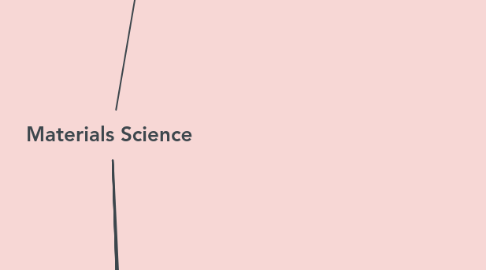
1. Structure of Materials
1.1. Areas of Influence
1.1.1. Lifetime
1.1.2. Production
1.1.3. Costs
1.1.4. Construction
1.1.5. Quality
1.1.6. Functionality
1.2. Properties
1.2.1. Strength
1.2.1.1. Crane
1.2.2. Strength specific weight
1.2.2.1. Aircraft
1.2.3. Corrosion resistance
1.2.3.1. Chemical plant
1.2.4. Thermal conductivity
1.2.4.1. Heat exchangers
1.2.5. Electric conductivity
1.2.5.1. Insulators
1.2.5.2. Semiconductors
1.2.6. Ferromagnetism
1.2.6.1. Magnets
1.2.7. Optical properties
1.2.7.1. Optical fiber
1.3. Kind of Materials General Description
1.3.1. Metals
1.3.1.1. Atomic structure
1.3.1.1.1. Metallic bond
1.3.1.1.2. Densest packing of atoms
1.3.1.1.3. Crystalline structure
1.3.1.2. Characteristics
1.3.1.2.1. Good electrical conductors
1.3.1.2.2. Good heat conductors
1.3.1.2.3. Reflect light
1.3.1.2.4. Chemically unstable
1.3.1.2.5. Well deformable low temperature
1.3.2. Ceramics
1.3.2.1. Atomic structure
1.3.2.1.1. Ionic bond
1.3.2.1.2. Some atomic bond
1.3.2.1.3. Basic inorganic building blocks
1.3.2.1.4. Crystalline and amorphous structures (glasses)
1.3.2.2. Characteristics
1.3.2.2.1. Bad electrical conductors
1.3.2.2.2. Bad heat conductors
1.3.2.2.3. Often transparent
1.3.2.2.4. Not plastic
1.3.2.2.5. Chemical resistant
1.3.2.2.6. High melting temperatures
1.3.3. Polymers
1.3.3.1. Atomic structure
1.3.3.1.1. Atomic bonding long chain molecules
1.3.3.1.2. Secondary valence forces between chains
1.3.3.1.3. Amorphous structure, partially crystalline
1.3.3.2. Characteristics
1.3.3.2.1. Bad electrical conductors
1.3.3.2.2. Brittle at low temperature
1.3.3.2.3. Deformable at high temperature
1.3.3.2.4. Lowe specific weight
1.3.3.2.5. Chemical resistant
1.3.3.2.6. Low temperature resistant
1.4. Phases
1.4.1. States of matter
1.4.1.1. Plasma
1.4.1.1.1. Electrons move independent of their nuclei
1.4.1.2. Gas
1.4.1.2.1. Atoms of molecules move freely
1.4.1.3. Liquid
1.4.1.3.1. Condensed state of matter
1.4.1.4. Solid
1.4.1.4.1. Crystal
1.4.1.4.2. Glasses (amorphous solids)
1.5. Crystalline Structures
1.5.1. Kinds
1.5.1.1. Simple Cubic (SC)
1.5.1.2. Body-center cubic (BCC)
1.5.1.2.1. Atoms touch along diagonals
1.5.1.3. Face-center cubic (FCC)
1.5.1.3.1. Atoms touch along surfaces
1.5.1.3.2. Aluminium, Nickel, Copper, Silver, Gold, Lead...
1.5.1.4. Hexagona close-packed (HCP)
1.5.1.4.1. Same as FCC
1.5.1.4.2. Magnesium, cobalt, Titanium, zinc
1.5.2. Description of Position within unit cell
1.5.2.1. 1
1.5.2.2. 2
1.5.3. Miller Indices
1.5.3.1. 1. Find intercept points in axist eg. (3,4,6)
1.5.3.2. 2. Reciprocals of them (1/3,1/4,1/6)
1.5.3.3. 3. Lowest common denominator (4/12,3/12,2/12)
1.5.3.4. 5.Miller Indices = (4,3,2)
1.5.3.5. Examples
1.5.3.5.1. 1
1.5.3.6. Distance between planes
1.5.3.6.1. 1
1.5.4. Crystals behave anisotropically
1.5.4.1. Anisotropy: is the property of being directionally dependent, which implies different properties in different directions, as opposed to isotropy.
1.6. Lattice Defects
1.6.1. Kinds
1.6.1.1. Zero-Dimensional - Point Defects
1.6.1.1.1. Vacancies
1.6.1.1.2. Impurities
1.6.1.2. One-Dimensional - Line Defects
1.6.1.2.1. Edge dislocation
1.6.1.2.2. Screw Dislocation
1.6.1.3. Two-Dimensional
1.6.1.3.1. Grain Boundary
1.6.1.3.2. Twin Boundaries
1.6.1.3.3. Stacking Fault
1.6.1.3.4. Anti-phase boundary
1.6.1.4. Three-Dimensional
1.6.1.4.1. Pore
1.6.1.4.2. Inclusions
1.6.2. Curing mechanisms
1.6.2.1. Kinds
1.6.2.1.1. 0D solute atoms = Solid solution hardening
1.6.2.1.2. Dislocations = Hardening
1.6.2.1.3. Grain boundaries = Fine grain hardening
1.6.2.1.4. 3D particles = Precipitation hardening
1.6.2.1.5. Crystal anisotropy = Texture hardening
1.6.2.1.6. Structural anisotropy = Fiber reinforcement
1.6.2.2. With the exception of fine grain hardening, INCREASE HARDNESS = DECREASE TOUGHNESS
1.6.2.2.1. HERE PAGE 38 WK2
2. Materials
2.1. Polymers
2.2. Metals
2.2.1. Iron Materials
2.2.2. Light metals
2.2.3. Heavy Metals
2.2.4. Metals Allotropic transformations
2.2.4.1. Allotropy: Elements can be present in different crystal structures
2.2.4.2. Polymorphism: compounds may exist in different crystal structures
2.2.4.3. It's when a metal can change its structure (for example bcc->fcc) after a heat process
2.2.5. Mechanical Properties of Metals
2.2.5.1. elastic and plastic behavior
2.2.5.1.1. Tensile load
2.2.5.1.2. Compresive load
2.2.5.1.3. Shear strain
2.2.5.2. fracture processes
2.2.5.3. static strength and toughness
2.2.5.4. thermal behavior
2.2.5.5. Creep (Deformation)
3. Thermally Activated Processes
3.1. Phase transformations and precipitation processes
3.2. Concentration equalization by diffusion
3.2.1. Equation through diffusion
3.2.1.1. Arrhenius Equation
3.2.1.1.1. dV/dt = reaction rate dV = activated volume k = constant
3.2.1.1.2. Q = activation energy R = universal gas constant T = absolute temperature
3.2.2. Volume Diffusion
3.2.2.1. interstitial Diffusion
3.2.2.2. vacancy diffusion
3.2.3. Diffusion Path
3.2.4. Elastic Band effect
3.3. Flick´s Law of diffusion
3.3.1. Growth And recrystallisation
3.3.2. Primary and secondary Recrystallisation
3.3.3. 1st Flick's Law
3.3.4. 2nd Flick's Law
3.4. Recrystallization of deformed structures
3.4.1. Rules for recrystallisation
3.4.1.1. Minimal temperature
3.4.1.1.1. Thermal recrystallization requires a minimum temperature for the necessary atomic mechanism to occur
3.4.1.2. Critical deformation
3.4.1.2.1. The prior deformation applied to the material must be adequate to provide nuclei and sufficient stored energy to drive their growth
3.4.1.3. Initial grain size affects the critical temperature
3.4.1.4. Deformation affects the final grain size
